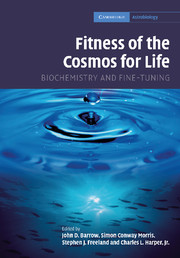Book contents
- Frontmatter
- Contents
- List of contributors
- Foreword: The improbability of life
- Preface
- Acknowledgments
- Part I The fitness of “fitness”: Henderson in context
- Part II The fitness of the cosmic environment
- 6 Fitness and the cosmic environment
- 7 The interconnections between cosmology and life
- 8 Chemistry and sensitivity
- 9 Fitness of the cosmos for the origin and evolution of life: from biochemical fine-tuning to the Anthropic Principle
- Part III The fitness of the terrestrial environment
- Part IV The fitness of the chemical environment
- Index
- References
7 - The interconnections between cosmology and life
Published online by Cambridge University Press: 18 December 2009
- Frontmatter
- Contents
- List of contributors
- Foreword: The improbability of life
- Preface
- Acknowledgments
- Part I The fitness of “fitness”: Henderson in context
- Part II The fitness of the cosmic environment
- 6 Fitness and the cosmic environment
- 7 The interconnections between cosmology and life
- 8 Chemistry and sensitivity
- 9 Fitness of the cosmos for the origin and evolution of life: from biochemical fine-tuning to the Anthropic Principle
- Part III The fitness of the terrestrial environment
- Part IV The fitness of the chemical environment
- Index
- References
Summary
Four basic observations
Progress in cosmology in the past few decades has also led to new insights into the global question of the emergence of intelligent life in the universe. I am referring not to discoveries that are related to very localized regions, such as the detection of 200 extrasolar planetary systems (at the time of writing), but rather to properties of the universe at large.
In order to set the stage properly for the topics that follow, I would like to start by presenting four observations with which essentially all astronomers agree. These four observations define the cosmological context of our universe and form the basis for any theoretical discussion.
Ever since the observations of Vesto Slipher in 1912–22 (Slipher, 1917) and Edwin Hubble (1929), we have known that the spectra of distant galaxies are red shifted.
Observations with the Cosmic Background Explorer (COBE) have shown that, to a precision of better than 10−4, the cosmic microwave background (CMB) is thermal, with a temperature of 2.73 K (Mather et al., 1994).
Light elements, such as deuterium and helium, have been synthesized in a high-temperature phase in the past (see, for example, Gamow, 1946; Alpher et al., 1948; Hoyle and Tayler, 1964; Peebles, 1966; Wagoner et al., 1967).
Deep observations, such as the Hubble Deep Field, and the Hubble Ultra Deep Field, have shown that galaxies in the distant universe look younger. Specifically, they are smaller (see, for example, Roche et al., 1996; Ferguson et al., 2004), and they have a higher fraction of irregular morphologies (see, for example, Abraham et al., 1996). This is what one would expect from a higher rate of interactions and from the “building blocks” of today's galaxies.
- Type
- Chapter
- Information
- Fitness of the Cosmos for LifeBiochemistry and Fine-Tuning, pp. 114 - 131Publisher: Cambridge University PressPrint publication year: 2007
References
- 1
- Cited by

